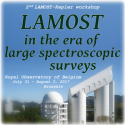Speaker
Dr
Gijs Mulders
(University of Arizona)
Description
Exoplanets around different type of stars provide a window into the diverse environments in which planets form. The mass and metallicity of exoplanet host stars reflect the conditions in the protoplanetary disks where these planets once formed. The relation between exoplanet populations and their host stars provide strong constraints on the planet formation process.
Giant planets occur more frequent around more massive and more metal-rich stars, as predicted by the core-accretion scenario for giant planet formation. Sub-Neptunes, those found in abundance with Kepler, occur around stars with a wide range of metallicities and, curiously, occur more frequently around low-mass M dwarfs than around solar-mass stars, challenging current paradigms in planet formation theory.
I will indicate areas where the LAMOST-Kepler project can continue to contribute to characterizing trends between exoplanets and their host stars, in particular in understanding how the population of the smallest exoplanets depends on stellar metallicity.
Primary author
Dr
Gijs Mulders
(University of Arizona)
Co-authors
Dr
Antonio Frasca
(INAF - Osservatorio Astrofisico di Catania)
Dr
Joanna Molenda-Zakowicz
(University of Wroclaw, Poland)

